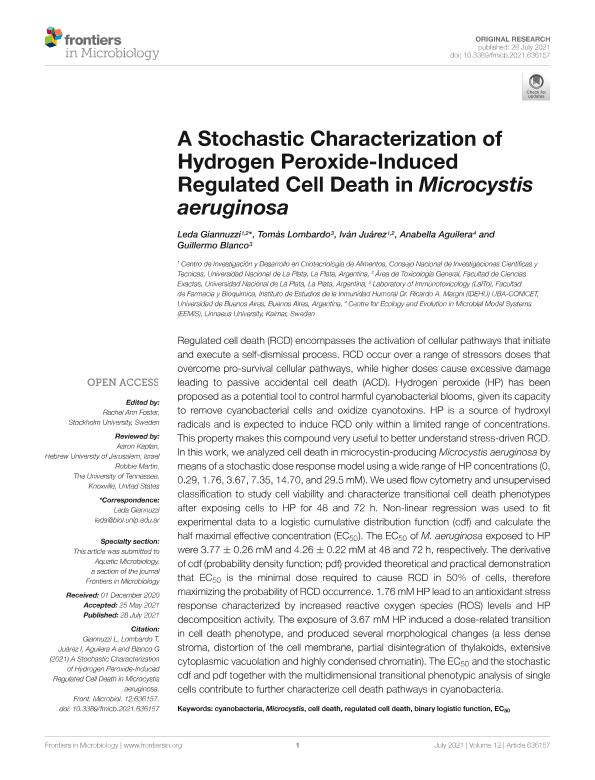Mostrar el registro sencillo del ítem
dc.contributor.author
Giannuzzi, Leda

dc.contributor.author
Lombardo, Tomás

dc.contributor.author
Juárez, Ivan

dc.contributor.author
Aguilera, Anabella

dc.contributor.author
Blanco, Guillermo
dc.date.available
2021-11-01T13:24:38Z
dc.date.issued
2021-07-28
dc.identifier.citation
Giannuzzi, Leda; Lombardo, Tomás; Juárez, Ivan; Aguilera, Anabella; Blanco, Guillermo; A stochastic characterization of hydrogen peroxide-induced regulated cell death in microcystis aeruginosa; Frontiers Media; Frontiers in Microbiology; 12; 28-7-2021; 1-15
dc.identifier.uri
http://hdl.handle.net/11336/145573
dc.description.abstract
Regulated cell death (RCD) encompasses the activation of cellular pathways that initiate and execute a self-dismissal process. RCD occur over a range of stressors doses that overcome pro-survival cellular pathways, while higher doses cause excessive damage leading to passive accidental cell death (ACD). Hydrogen peroxide (HP) has been proposed as a potential tool to control harmful cyanobacterial blooms, given its capacity to remove cyanobacterial cells and oxidize cyanotoxins. HP is a source of hydroxyl radicals and is expected to induce RCD only within a limited range of concentrations. This property makes this compound very useful to better understand stress-driven RCD. In this work, we analyzed cell death in microcystin-producing Microcystis aeruginosa by means of a stochastic dose response model using a wide range of HP concentrations (0, 0.29, 1.76, 3.67, 7.35, 14.70, and 29.5 mM). We used flow cytometry and unsupervised classification to study cell viability and characterize transitional cell death phenotypes after exposing cells to HP for 48 and 72 h. Non-linear regression was used to fit experimental data to a logistic cumulative distribution function (cdf) and calculate the half maximal effective concentration (EC50). The EC50 of M. aeruginosa exposed to HP were 3.77 ± 0.26 mM and 4.26 ± 0.22 mM at 48 and 72 h, respectively. The derivative of cdf (probability density function; pdf) provided theoretical and practical demonstration that EC50 is the minimal dose required to cause RCD in 50% of cells, therefore maximizing the probability of RCD occurrence. 1.76 mM HP lead to an antioxidant stress response characterized by increased reactive oxygen species (ROS) levels and HP decomposition activity. The exposure of 3.67 mM HP induced a dose-related transition in cell death phenotype, and produced several morphological changes (a less dense stroma, distortion of the cell membrane, partial disintegration of thylakoids, extensive cytoplasmic vacuolation and highly condensed chromatin). The EC50 and the stochastic cdf and pdf together with the multidimensional transitional phenotypic analysis of single cells contribute to further characterize cell death pathways in cyanobacteria.
dc.format
application/pdf
dc.language.iso
eng
dc.publisher
Frontiers Media

dc.rights
info:eu-repo/semantics/openAccess
dc.rights.uri
https://creativecommons.org/licenses/by/2.5/ar/
dc.subject
BINARY LOGISTIC FUNCTION
dc.subject
CELL DEATH
dc.subject
CYANOBACTERIA
dc.subject
EC50
dc.subject
MICROCYSTIS
dc.subject
REGULATED CELL DEATH
dc.subject.classification
Otras Ciencias Naturales y Exactas

dc.subject.classification
Otras Ciencias Naturales y Exactas

dc.subject.classification
CIENCIAS NATURALES Y EXACTAS

dc.title
A stochastic characterization of hydrogen peroxide-induced regulated cell death in microcystis aeruginosa
dc.type
info:eu-repo/semantics/article
dc.type
info:ar-repo/semantics/artículo
dc.type
info:eu-repo/semantics/publishedVersion
dc.date.updated
2021-10-26T14:30:31Z
dc.identifier.eissn
1664-302X
dc.journal.volume
12
dc.journal.pagination
1-15
dc.journal.pais
Estados Unidos

dc.description.fil
Fil: Giannuzzi, Leda. Provincia de Buenos Aires. Gobernación. Comisión de Investigaciones Científicas. Centro de Investigación y Desarrollo en Criotecnología de Alimentos. Consejo Nacional de Investigaciones Científicas y Técnicas. Centro Científico Tecnológico Conicet - La Plata. Centro de Investigación y Desarrollo en Criotecnología de Alimentos. Universidad Nacional de La Plata. Facultad de Ciencias Exactas. Centro de Investigación y Desarrollo en Criotecnología de Alimentos; Argentina
dc.description.fil
Fil: Lombardo, Tomás. Consejo Nacional de Investigaciones Científicas y Técnicas. Oficina de Coordinación Administrativa Houssay. Instituto de Estudios de la Inmunidad Humoral Prof. Ricardo A. Margni. Universidad de Buenos Aires. Facultad de Farmacia y Bioquímica. Instituto de Estudios de la Inmunidad Humoral Prof. Ricardo A. Margni; Argentina
dc.description.fil
Fil: Juárez, Ivan. Provincia de Buenos Aires. Gobernación. Comisión de Investigaciones Científicas. Centro de Investigación y Desarrollo en Criotecnología de Alimentos. Consejo Nacional de Investigaciones Científicas y Técnicas. Centro Científico Tecnológico Conicet - La Plata. Centro de Investigación y Desarrollo en Criotecnología de Alimentos. Universidad Nacional de La Plata. Facultad de Ciencias Exactas. Centro de Investigación y Desarrollo en Criotecnología de Alimentos; Argentina
dc.description.fil
Fil: Aguilera, Anabella. Linnaeus University; Suiza
dc.description.fil
Fil: Blanco, Guillermo. Consejo Nacional de Investigaciones Científicas y Técnicas. Oficina de Coordinación Administrativa Houssay. Instituto de Estudios de la Inmunidad Humoral Prof. Ricardo A. Margni. Universidad de Buenos Aires. Facultad de Farmacia y Bioquímica. Instituto de Estudios de la Inmunidad Humoral Prof. Ricardo A. Margni; Argentina
dc.journal.title
Frontiers in Microbiology
dc.relation.alternativeid
info:eu-repo/semantics/altIdentifier/doi/http://dx.doi.org/10.3389/fmicb.2021.636157
dc.relation.alternativeid
info:eu-repo/semantics/altIdentifier/url/https://www.frontiersin.org/articles/10.3389/fmicb.2021.636157/full
Archivos asociados
